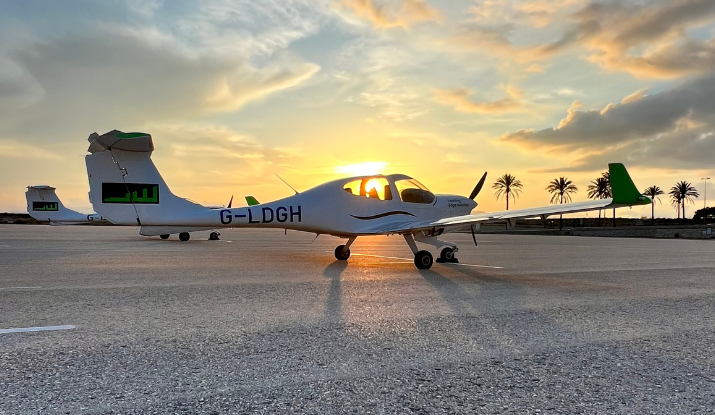Aviation Glossary

Say again? Have you noticed there’s a tonne of jargon used in aviation?
All the acronyms you hear around a flight school can be tricky to decode at first. So, we’ve put together a glossary to explain exactly what those mysterious letter combinations mean.
Here’s a guide to some of the most common acronyms and terms you’ll come across during flight and airline training.
Aviation Agencies and Authorities
- ICAO – International Civil Aviation Organisation
- EASA – European Aviation Safety Agency
- CASA – Civil Aviation Safety Authority (Australia)
- CAA – Civil Aviation Authority (UK)
- FAA – Federal Aviation Authority (USA)
Pilot Licences
Part-FCL are the EASA Flight Crew Licences.
The licences are:
- LAPL(A) – Light Aircraft Pilot Licence (for restricted leisure flying in smaller single engine piston aeroplanes only)
- PPL – Private Pilot Licence
- CPL – Commercial Pilot Licence
- IR – Instrument Rating
- MECPL – Multi-Engine Commercial Pilot Licence
- MEP – Multi-Engine Piston Rating
- MEIR – Multi-Engine Instrument Rating
- MPL – Multi Crew Pilot Licence
- fATPL – ‘Frozen’ Airline Transport Pilot Licence (a colloquial term for a CPL+MEP/IR + APS MCC)
- ATPL – Airline Transport Pilot Licence
- APS MCC – Airline Pilot Standards Multi Crew Cooperation Course
Licences are further classified by aircraft type, the main two being aeroplanes (A) and helicopters (H). So, our students will graduate with a ‘frozen’ ATPL(A).
Other Pilot Training Courses
- Rating – An additional qualification associated with a licence. E.g. The CPL gives the pilot the privileges of of being able to fly for money. The addition of an MEP allows the pilot to do it in a twin engine aircraft.
- SEP – Single Engine Piston Rating
- MEP – Multi Engine Piston Rating
- NQ – Night Qualification
- IMC – Instrument Meteorological Conditions Rating (allows a PPL holder to fly in IMC within the UK within certain minimums)
- CRM – Crew Resource Management
- Type Rating – the qualification undertaken by a fATPL holder in order to fly a particular aircraft type (eg. B737)
- LST – Licence Skills Test (flight test at the end of your type rating)
- Line Training – (flying under supervision as the final part of type training)
- Base training (take off and landings in the aircraft required for the issue of a type rating)
- Line Check – (check flight conducted at the end of line training)
- LPC – Licence Proficiency Check (annual check for the revalidation of your type rating)
- OPC – Operator Proficiency Check (a 6 monthly check by the airline. In practice, very similar to an LPC)
- UPRT – Upset Prevention and Recovery Training
Flight Training Organisations
- ATO – Approved Training Organisation (formerly known as FTO)
- CTKI – Chief Theoretical Knowledge Instructor
- CFI – Chief Flying Instructor
- TKI – Theoretical Knowledge Instructor
- FI – Flight Instructor
- Integrated pilot training – zero hours to fATPL with one ATO e.g. LEAP
- Modular pilot training – Individual licences completed to fATPL, step by step at one or more ATOs. e.g. Modular
- Ab Initio – ‘from the beginning.’ (Usually refers to initial pilot training, or a person with no previous experience.)
- MPL – Multi-pilot licence. (An alternative to ATPL, an MPL is professional pilot qualification designed for a specific airline and a specific aircraft type)
- The regulating authority (EASA in the UK) must approve all pilot training organisations (ATOs) and a student must be formally registered with one in order to train as a commercial pilot.
Aviation Medicals
- AME – Aeromedical Examiner
- Class 1 Medical – Full medical (required for CPL, MPL and ATPL)
- Class 2 Medical – Medical (required for PPL)
Medicals must be conducted by an approved AME; doctors with specialist aviation medicine training. They are certificated by the CAA
to carry out aircrew medical examinations and to give aviation medicine advice, as necessary.
Terminology you’ll hear in pilot training
- ATC – air traffic control
- CRP 5 – a manual flight computer
- IFR – Instrument Flight Rules
- IMC – Instrument Meteorological Conditions
- VFR – Visual Flight Rules
- FTD – Flight Training Device
- Ground School – theoretical knowledge training, also known as ATPL theory
- FMC – Flight Management Computer
- SOP – Standard Operating Procedures
- IELTS – International English Language Training Standard
- ICAO Level 4 – The minimum ICAO Standard for English Language proficiency for ATPL.
